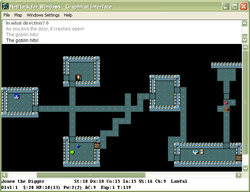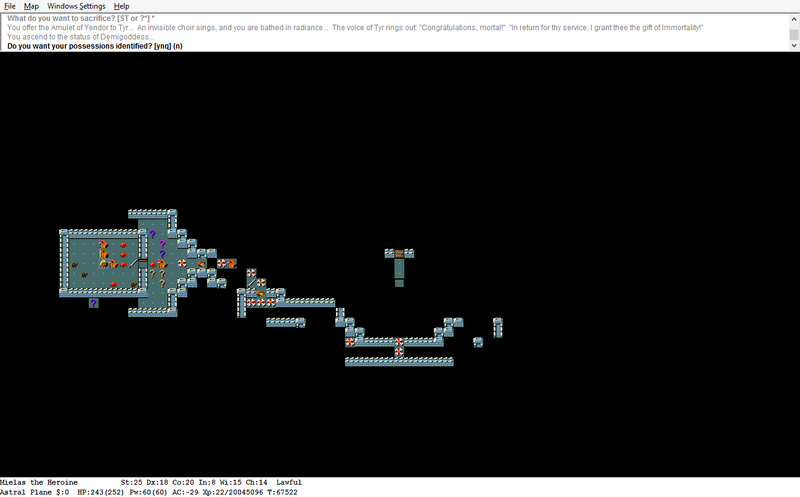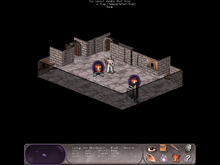NetHack
| NetHack
|
|
|---|---|
 Nethack with graphic tileset |
|
| Basic data
|
|
| developer | The NetHack DevTeam |
| Publishing year | 1987 |
| Current version | 3.6.6 (March 13, 2020) |
| operating system | Platform independent |
| programming language | C. |
| category | Rogue-like computer role-playing game |
| License | Nethack General Public License |
| www.nethack.org | |
NetHack is a rogue-like computer role-playing game that was first released in 1987.
The game was originally published in English. Linguistic localized versions are available (in different stages of development) in German, Japanese and Spanish.
The game is released under the Nethack General Public License, a variant of the GPL . NetHack is therefore free software .
General
NetHack is a further development of an older game called Hack (1984), the content of which is based on Rogue (1980).
The game, NetHack, owes its name to the fact that it was created by a group of developers that communicated over the network. NetHack was originally played with a surface based on ASCII characters. It was possible to play games on a CP / M computer with a monochrome screen after a connection to a server on which Nethack was installed was established via a 2400 baud modem. Today, the appealing graphic game form (tiles) is preferred by most players for the humor comic role-playing game. Nethack has been ported to many different operating systems.
Despite the possibility of playing Nethack online via Telnet or graphically using a web browser, it is a purely single player game. A multiplayer mode is not implemented. It is part of the game concept, however, that from time to time you stumble upon the ghosts of a character who died in a previous game and their treasures that the other player had collected until the character died.
The aim of the game is to find the Amulet of Yendor , which was stolen by the evil god Moloch, in the depths of a dungeon and thus to escape alive from the depths. The dungeon consists of at least forty levels, mostly randomly generated, full of monster encounters, useful and magical items and labyrinth puzzles.
"After the Creation, the cruel god Moloch rebelled against the authority of Marduk the Creator. Moloch stole from Marduk the most powerful of all the artifacts of the gods, the Amulet of Yendor, and he hid it in the dark cavities of Gehennom , the Under World, where he now lurks, and bides his time. "
“After the completion of creation, the cruel god Moloch rebelled against the supremacy of Marduk the Creator. Moloch stole the most powerful of all artifacts of the gods, the amulet of Yendor, from Marduk and hid it in the dark caverns of Gehennom , the underworld, where he has been up to mischief ever since. "
At the beginning of the game, the character is accompanied by a named and combative pet, either a cat or a dog; a knight is accompanied by a saddled riding horse. As the game progresses, more monsters can be tamed , some by feeding them, some by magic. These tame monsters are very useful: Not only are they of great help in combat, they also give clues to cursed items and help steal expensive items from rare shops.
Nethack is not one of the usual real-time hack-and-slay games , but is turn-based : the player makes a move, then the monsters, and then the player can think about his next move again.
The satirical humor, the breadth and depth of play of NetHack are great: Hundreds of individual objects, situations and monsters sometimes enable extensive interactions with the game world. You can dig new passages with a pickaxe or a dig-wand, you have to deal with greedy, thieving nymphs and leprechauns, with succubi there is eroticism, you have to find secret doors and locked treasure chests and doors have to be opened somehow.
There is a saying that the development team, called DevTeam, literally thinks of everything ("the DevTeam thinks of everything") - every possible course of action of the character should have the DevTeam already considered with an appropriate response.
For example, if you try to dip a magic potion in yourself, you get the following message:
"That is a potion bottle, not a small bottle !"
"This is a potion bottle, not a Klein bottle !"
Another example is if the character has too many things with him and is therefore burdened: The attempt to go down a flight of stairs in this state ends with this response:
"You fall down the stairs."
"You fall down the stairs."
Monsters from various fields are integrated - from Medusa to hobbits and even from quantum mechanics : When opening a box, it can happen that Schrödinger's cat is in it - dead or alive.
Bugs , assistance, funny or remarkable game situations and ideas for future versions of the game are discussed on Usenet in the newsgroup rec.games.roguelike.nethack .
There are also some websites that collect so-called spoilers . These are instructions, assistance or references that "spoil" the player, i.e. possibly spoil the fun of the game, because they contain information that he could have found out himself while playing. There is also a program that automatically creates such spoilers from the NetHack source code .
Playable classes
The player can choose from a total of 13 roles, 5 races and 3 orientations. The following combinations are possible:
| Righteous | Neutral | Chaotic | |||||
|---|---|---|---|---|---|---|---|
| roll | human | dwarf | human | gnome | human | Eleven | Orc |
| archaeologist | Yes | Yes | Yes | Yes | No | No | No |
| Barbarian | No | No | Yes | No | Yes | No | Yes |
| Caveman | Yes | Yes | Yes | Yes | No | No | No |
| healer | No | No | Yes | Yes | No | No | No |
| Knight | Yes | No | No | No | No | No | No |
| monk | Yes | No | Yes | No | Yes | No | No |
| priest | Yes | No | Yes | No | Yes | Yes | No |
| Ranger | No | No | Yes | Yes | Yes | Yes | Yes |
| Villain | No | No | No | No | Yes | No | Yes |
| samurai | Yes | No | No | No | No | No | No |
| tourist | No | No | Yes | No | No | No | No |
| Valkyrie | Yes | Yes | Yes | No | No | No | No |
| magician | No | No | Yes | Yes | Yes | Yes | Yes |
The graphic
The following picture is an example of a typical game situation with so-called IBMgraphics, so called because it uses characters from code page 437 , the standard character set of the IBM PC :
Legend: @ - The player figure <,> - stairs up / down, _ - altar, % - something edible, + - magic book or a closed door, / - magic wand, ( - device, ) - weapon, [ - armor, * - (Gem) stone etc.
The text field at the bottom conveys the various properties of the game character: St = Strength, Dx = Dexterity, Co = Constitution, In = Intelligence, Wi = Wisdom, Ch = Charisma, HP = Hitpoints, Pw = MagicPower, AC = Armor-Class etc. .
Lilian, a chaotic orc barbarian @ , is shown at the 32.036. Move. It is located in "Minetown", the center of a branch of the dungeon, where it is in a closed room directly opposite a temple (recognizable by the altar '_' symbol). The objects lying around in the open spaces and corridors point to earlier fights. Small rooms with collections of objects are often shops.
The following picture shows a game scene with so-called tiles :
As a Valkyrie, the player has reached the end of the astral levels and has risen to the status of a demigod , the so-called Ascension . The game asks "Do you want your possessions identified?" (German: "Do you want to have identified your property?"). A sentence that is also displayed when the player character dies.
Other versions and user interfaces
Since NetHack is free software and so anyone can change the freely available code, a number of variants and user interfaces existed.
German version
The German version of NetHack 3.4.3 is called NetzHack (with a 'z'). It was developed between 2007 and 2013 by Karl Breuer and Tony Crawford and runs on Unix-like systems (Linux, macOS and other BSD variants) and Windows .
A parallel translation project, Nethack-De by Patric Mueller, is still incomplete today, but can be played as a work-in-progress.
Slash'EM
A NetHack fork that is very popular today is Slash'EM (the name is a backronym for Super Lots of Added Stuff Hack - Extended Magic ). This was originally a modification based on version 3.3.1 from NetHack, which combines the SLASH patch by Tom Proudfoot with the Wizard patch by Larry Stewart-Zerba. Slash'EM is generally ahead of NetHack when it comes to introducing new objects and ideas, but is generally considered to be less stable and more difficult to learn because of the wealth of details. The game has a dual license consisting of the MIT license and NetHack GPL.
User interfaces
In addition to the original ASCII mode, there is also a much more popular graphic game form in which images (tiles) are used instead of ASCII symbols. This look is similar to an interactive comic role-playing game world.
- noegnud (also noeGNUd, backwards from dungeon), uses SDL and can be used as a frontend for NetHack and Slash'EM
- glhack is a NetHack front end that uses OpenGL
- nethack-el allows you to play NetHack in Emacs
- Falcon's Eye is a graphical version of NetHack with 3D support (no longer in development)
- Vulture (based on and replaces Falcon's Eye) is available as a front end for NetHack (Vulture's Eye) and Slash'EM (Vulture's Claw) and supports 3D views
There is also a front end for Qt and Gnome .
Web links
- Official NetHack website
- NethackWiki - Comprehensive NetHack Wiki
- NetHack alt.org (NAO) - Popular NetHack server
Individual evidence
- ↑ The NetHack DevTeam is announcing the release of NetHack 3.6.6 on March 8, 2020. In: nethack.org. March 8, 2020, accessed on March 13, 2020 .
- ↑ The nethack Open Source Project on Open Hub: Languages Page . In: Open Hub . (accessed on July 18, 2018).


